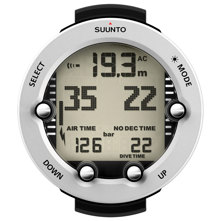My "happy spot" on dives is 20 to 45 feet of water.
I am going to ignore that for the body of this post. You don’t even need a computer if this is really what you are doing. Follow the guide, you will be fine.
Somewhere around North of $500 USD / day on a typical week long trip with 5 days of diving. Depending on where you are going and the cost of getting there it might be more or less.
$500/day for shallow sites?
Since you don’t want to do any trimix or CCR a Shearwater Peregrine will be ideal. You already have AI on the first computer. If you insist on a removable battery then you have to have a Perdix. You seem to prefer the removable battery but I find the battery indicator on my one is a bit rubbish and have had it die mid dive. By contrast the coil cell style battery on a mono LCD computer lives for a year at least and properly lets you know it is on the way out. So the rechargeable vs AA isn’t so clear cut once you start using it.
These are the Sharewater backup analogue dive computers to go along with your tables. A rec and a tech version. Batteries not required.
View attachment 709207
View attachment 709208
This is the textbook scheme for proper diving. I suspect many on this thread are unaware of what proper planning looks like.
The way it worked was you plan a dive up front.
Say you know you are diving a 40m wreck you’d figure out how long you could do by planning various times and seeing how much gas you’d need. This gets easier with a deco gas as there is generally plenty and all you have to do is figure out the backgas. Anyway by some means you decide to do say 30 minutes and some deco plan like 1/2/5/23 minutes on some gas the cool kids like. You also end up with a limit based on back gas pressure.
You put that plan on a slate, along with some deeper/longer plans incase you make a mistake Or something unexpected happens.
In the water a timer/depth gauge combo (aka bottom timer) lets you follow the plan. As backup you have two timers.
This is pretty time consuming and not flexible. If the wreck is not flat then some of the time will be shallower and you still need to leave the bottom at 30 minutes and then do all the same deco regardless. If instead you use a computer you get to stay longer (caution required regarding back gas) and do the actual deco. The trouble is what happens if that computer fails? Now you have to get back to the slate plan using the bottom timer but do not know if you exceeded the envelope of that plan. Thus in such a scheme you can not extend bottom time if doing well on gas or it is actually a bit shallower. You could take some extra “just shallower/just longer plans” but people don’t/didn’t.
So the answer is to have two similar(ish) computers each capable of getting you out of the water. (Or assume your buddy will have a similar profile but that is frowned upon.)
It can take a lot of lying to yourself to risk lying to your significant other about why you MUST have the toy peer pressure says is the cool toy today or covering it up. One particular lie popular on SB is that you should ”buy once cry once” and so, in this context, buy a £1000 computer at the start when you have no idea what is what yet. Everyone who is not doing trimix or doesn’t have £2k to burn will be better to have two Peregrines. So start with the cheap option and add trimix/CCR later. For CCR you only need one standalone computer as backup so you actually never need to own two stupidly expensive computers.
I usually dive a rebreather with a Petrel as the primary and a Perdix as a backup. Before I bought the Perdix I used a HelO2 as the backup. Before the rebreather I used the HelO2 as the main computer and a Zoop as the backup (some times bending the Zoop so it was essentially a bottom timer) with a slate.
For OC deco diving I now use the Perdix as the primary computer and the HelO2 as the backup.
There are many ways to improve your enjoyment of diving more than buying an expensive computer. Drysuits, holidays, etc. For the price of a Teric and transmitter or two Perdix AIs you could do both ANDP and 60m Trimix. The Garmin and in some markets the Suunto Eon Steel are equally expensive, this is not an anti Shearwater thing, more an anti received wisdom thing.
Diving is hand-delivering that money to the water.





